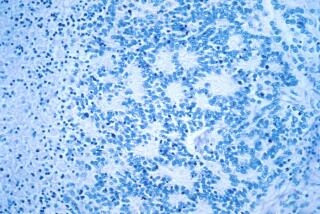Surgery Tames Brain Tumors in Children : Pediatrics: Each year, about 300 astrocytomas are diagnosed in the United States. Now youngsters can undergo a pioneering operation that has a 95% success rate.
- Share via
NEW YORK — Nine-year-old Toni Anne Collasso didn’t want to eat. She was listless and tired. She had splitting headaches. Her peripheral vision was shrinking.
A neurologist finally diagnosed her problem: a slow-growing tumor in the brain stem. Fifteen years ago such tumors were considered inoperable. Inevitably, they caused paralysis and death.
Then Dr. Fred J. Epstein, a pediatric neurosurgeon, developed a procedure that allowed surgeons to operate and remove the tumor. So when Toni Anne came to see him at the New York University Medical Center, he could offer some hope.
“After the operation, she was just terrific,” said her mother, Elaine Collasso. “In fact, even her vision came back.
Each year, about 300 such tumors, called astrocytomas, are diagnosed in the United States. Now children with the tumors can undergo an operation that has a 95% success rate.
Dr. David McLone, past president of the American Society of Pediatric Neurosurgery, credits Epstein for developing the procedure in the late 1970s.
“It was regarded by most people as inoperable until Fred developed the technique, did them and showed other people how to do this,” McLone said.
There are fewer than 85 pediatric neurosurgeons in North America. They must have six years of neurosurgery residence and one year of pediatric neurosurgery with one of the 12 doctors who teach it.
Children from all over the world come to the division of pediatric neurosurgery that Epstein, 53, founded in 1984 at the hospital in Manhattan. Pediatric neurosurgery didn’t exist as a medical specialty when Epstein first became fascinated with the tumors that were killing children about the age of his youngsters.
“My interest evolved when I noticed that there were a number of tumors in the brain stem that were not cancerous, and we were always told you could not operate on them,” Epstein said.
“It seemed crazy to me that a tumor that was slow growing should be fatal. These same tumors when they occur elsewhere in the brain were curable.”
Surgeons had been removing slow-growing tumors from the brain since the early 1940s, but tumors in the brain stem were considered inoperable because a slip could kill, paralyze or leave a child mentally retarded.
Some of the tumors grow tentacle-like around both the spinal cord and brain stem, strangling the vital nerves that connect the brain to the rest of the body.
Epstein thought that new technology--powerful microscopes, ultrasound and lasers--could enable him to operate safely. He compares removing the tumors to removing the lead from a pencil.
“If we can fillet the spinal cord, then we can see the tumor and use the new systems, the lasers and ultrasound, to remove the tumor without injuring the spinal cord,” he said.
Epstein, who removes about 150 astrocytomas a year, also operates on other tumors in the brain and spinal cord. He makes the surgery sound easy and exudes confidence, despite the risk involved.
“How could we not give hope that I don’t feel?” he said. “You have to believe you can do it or you won’t do it when you can do it.”
Epstein spends four days a week in the operating room; he also sees about 25 patients in his office.
“Children aren’t meant to be so sick, but they are,” Epstein said. “. . . With children, you have to take greater chances. We have a mandate. With children, you are playing for 100 years.”






